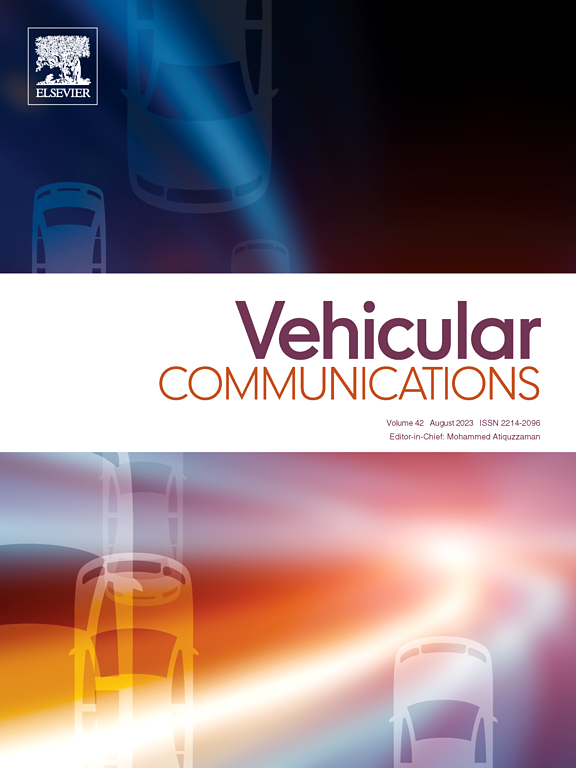A novel cylindrical filtering-based greedy perimeter stateless routing scheme in flying ad hoc networks
IF 6.5
2区 计算机科学
Q1 TELECOMMUNICATIONS
引用次数: 0
Abstract
Flying ad hoc networks (FANETs) are a new example of ad hoc networks, which arrange unmanned aerial vehicles (UAVs) in an ad hoc form. The features of these networks, such as the movement of UAVs in a 3D space, high speed of UAVs, dynamic topology, limited resources, and low density, have created vital challenges for communication reliability, especially when designing routing methods in FANETs. In this paper, a novel cylindrical filtering-based greedy perimeter stateless routing scheme (CF-GPSR) is suggested in FANETs. In CF-GPSR, cylindrical filtering reduces the size of the initial candidate set to accelerate the selection of the next-hop node. In this phase, the formulation of the cylindrical filtering construction process is expressed in the cylindrical coordinate system because the filtered area is a cylinder enclosed within the communication range of flying nodes. The cylindrical filtering construction process includes three steps, namely transferring coordinate axes, rotating coordinate axes, and cylinder construction. When selecting the next-hop node, CF-GPSR first uses this cylindrical filtering to limit the candidate set of each flying node. Then, CF-GPSR decides on the best next-hop UAV based on a merit function, which includes four criteria, namely velocity factor, ideal distance, residual energy, and movement angle, and selects a candidate node with the highest merit value as the next-hop UAV. Finally, the simulation process is performed using the NS 3.23 simulator, and four simulation scenarios are defined based on the number of UAVs, the communication area of nodes, network connections, and the size of packets to evaluate CF-GPSR. In the simulation process, CF-GPSR is compared with the three GPSR-based routing schemes, namely UF-GPSR, GPSR-PPU, and GPSR in terms of delay, data delivery ratio, data loss ratio, and throughput. In the first scenario, namely the change in the number of flying nodes, CF-GPSR improves delay, PDR, PLR, and throughput by 17.34%, 4.83%, 16%, and 7.05%, respectively. Also, in the second scenario, namely the change in communication range, the proposed method optimizes delay, PDR, PLR, and throughput by 4.91%, 5.71%, 6.12%, and 8.45%, respectively. In the third scenario, namely the change in the number of connections, CF-GPSR improves EED, PDR, PLR, and throughput by 18.41%, 9.09%, 9.52%, and 7.03%, respectively. In the fourth simulation scenario, namely the change in the packet size, CF-GPSR improves delay, PDR, PLR, and throughput by 14.81%, 19.39%, 7.19%, and 0.39%, respectively.
一种新的基于圆柱滤波的贪婪周长无状态自组网路由方案
飞行自组织网络(fanet)是一种新的自组织网络,它将无人机以自组织的形式进行布置。这些网络的特点,如无人机在三维空间中的移动、无人机的高速、动态拓扑、有限的资源和低密度,对通信可靠性造成了重大挑战,特别是在设计fanet中的路由方法时。提出了一种新的基于圆柱滤波的贪婪周长无状态路由方案(CF-GPSR)。在CF-GPSR中,圆柱滤波减小了初始候选集的大小,加快了下一跳节点的选择。在此阶段中,由于滤波区域是封闭在飞行节点通信范围内的圆柱体,因此圆柱滤波构建过程的公式用圆柱坐标系表示。圆柱过滤构造过程包括三个步骤,即传递坐标轴、旋转坐标轴和圆柱构造。在选择下一跳节点时,CF-GPSR首先使用该圆柱滤波来限制每个飞行节点的候选集。然后,CF-GPSR基于包含速度因子、理想距离、剩余能量和运动角度四个标准的价值函数确定最佳下一跳无人机,并选择价值值最高的候选节点作为下一跳无人机。最后,利用NS 3.23模拟器进行仿真,并根据无人机数量、节点通信区域、网络连接和数据包大小定义4种仿真场景,对CF-GPSR进行评估。在仿真过程中,将CF-GPSR与基于GPSR的三种路由方案(UF-GPSR、GPSR- ppu和GPSR)在时延、数据投递率、数据丢包率和吞吐量等方面进行了比较。在第一种场景下,即飞行节点数量的变化,CF-GPSR分别使时延、PDR、PLR和吞吐量提高17.34%、4.83%、16%和7.05%。在第二种情况下,即通信范围发生变化时,所提方法的时延、PDR、PLR和吞吐量分别优化了4.91%、5.71%、6.12%和8.45%。在第三种场景,即连接数变化的情况下,CF-GPSR可使EED、PDR、PLR和吞吐量分别提高18.41%、9.09%、9.52%和7.03%。在第四种模拟场景中,即数据包大小的变化,CF-GPSR分别提高了14.81%、19.39%、7.19%和0.39%的时延、PDR、PLR和吞吐量。
本文章由计算机程序翻译,如有差异,请以英文原文为准。
求助全文
约1分钟内获得全文
求助全文
来源期刊

Vehicular Communications
Engineering-Electrical and Electronic Engineering
CiteScore
12.70
自引率
10.40%
发文量
88
审稿时长
62 days
期刊介绍:
Vehicular communications is a growing area of communications between vehicles and including roadside communication infrastructure. Advances in wireless communications are making possible sharing of information through real time communications between vehicles and infrastructure. This has led to applications to increase safety of vehicles and communication between passengers and the Internet. Standardization efforts on vehicular communication are also underway to make vehicular transportation safer, greener and easier.
The aim of the journal is to publish high quality peer–reviewed papers in the area of vehicular communications. The scope encompasses all types of communications involving vehicles, including vehicle–to–vehicle and vehicle–to–infrastructure. The scope includes (but not limited to) the following topics related to vehicular communications:
Vehicle to vehicle and vehicle to infrastructure communications
Channel modelling, modulating and coding
Congestion Control and scalability issues
Protocol design, testing and verification
Routing in vehicular networks
Security issues and countermeasures
Deployment and field testing
Reducing energy consumption and enhancing safety of vehicles
Wireless in–car networks
Data collection and dissemination methods
Mobility and handover issues
Safety and driver assistance applications
UAV
Underwater communications
Autonomous cooperative driving
Social networks
Internet of vehicles
Standardization of protocols.
 求助内容:
求助内容: 应助结果提醒方式:
应助结果提醒方式:


